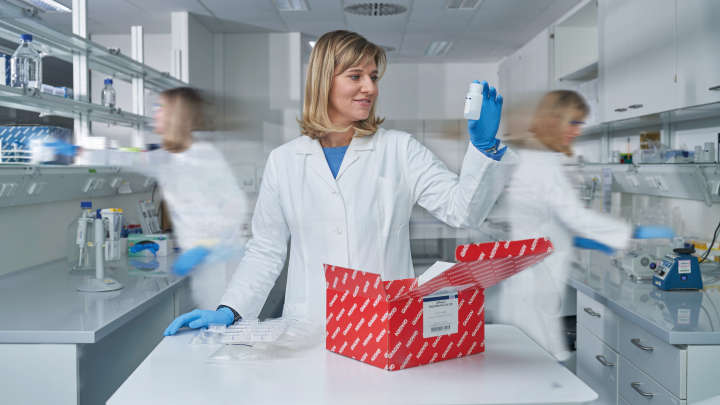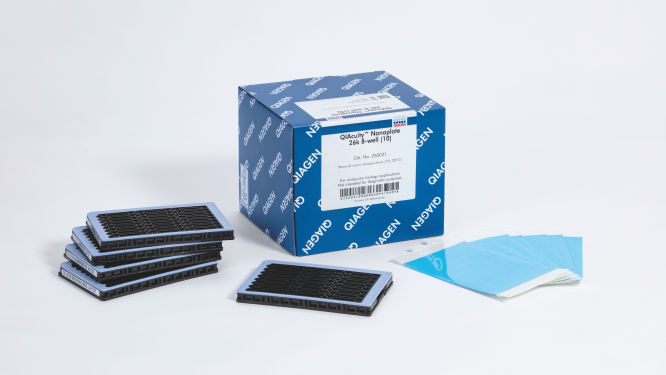✓ Procesamiento automático sin interrupción de pedidos en línea
✓ Servicio técnico y para productos experto y profesional
✓ Realización y repetición de pedidos rápidas y fiables
QIAcuity Nanoplate 26k 8-well (10)
N.º de cat. / ID. 250031
✓ Procesamiento automático sin interrupción de pedidos en línea
✓ Servicio técnico y para productos experto y profesional
✓ Realización y repetición de pedidos rápidas y fiables
Características
- Cuatro nanoplacas para diferentes necesidades de aplicación
- Hasta 8500 o 26 000 divisiones por pocillo
- Formato SBS
Detalles del producto
Las QIAcuity Nanoplates son placas de PCR digital de microfluidos que permiten analizar 8, 24 o 96 muestras con un máximo de 8500 o 26 000 divisiones por pocillo. Las cuatro nanoplacas están diseñadas para utilizarse en los instrumentos de dPCR QIAcuity.
Las nanoplacas solo pueden utilizarse con el QIAcuity Digital PCR System. Use el QIAcuity Nanoplate Adapter dedicado al llevar a cabo la configuración automatizada de PCR y manipulación de líquido en una QIAcuity Nanoplate con el sistema QIAgility. Una vez hecho esto, cargue la placa en el QIAcuity Digital PCR System para la reacción de dPCR.
¿Le gustaría obtener más información sobre el producto y que uno de nuestros especialistas en dPCR se ponga en contacto con usted? Regístrese aquí y nos pondremos en contacto con usted en breve.
Rendimiento
Estas placas están especialmente diseñadas para utilizarse con reacciones de PCR digital en los instrumentos QIAcuity. QIAGEN ofrece cuatro tipos de nanoplacas, todas con formato SBS, pero con diferentes especificaciones para distintas necesidades de aplicación.
| Tipo | Color del bastidor | Especificaciones | Aplicaciones |
| Nanoplate 26K 8-well | Azul claro |
8 pocillos × aprox. 26 000 divisiones Reacción de dPCR de 40 µl por pocillo |
Detección de mutaciones poco frecuentes, biopsia líquida, análisis de expresión génica, detección de microrganismos patógenos, etc. |
| Nanoplate 26K 24-well | Azul |
24 pocillos × aprox. 26 000 divisiones Reacción de dPCR de 40 µl por pocillo |
Detección de mutaciones poco frecuentes, biopsia líquida, análisis de expresión génica, detección de microrganismos patógenos, etc. |
| Nanoplate 8.5K 24-well | Blanco |
24 pocillos × aprox. 8500 divisiones Reacción de dPCR de 12 µl por pocillo |
Análisis de variación en el número de copias, análisis de expresión génica, cuantificación de la genoteca de NGS, detección de modificaciones del genomas, etc. |
| Nanoplate 8.5K 96-well | Gris |
96 pocillos × aprox. 8500 divisiones Reacción de dPCR de 12 µl por pocillo |
Principio
En solo 3 simples pasos, puede obtener el resultado de dPCR que desea en menos de dos horas: pipetee y cargue, realice el experimento y analice los resultados. El principio de la reacción de dPCR en las nanoplacas se describe aquí.
Procedimiento
Al igual que en los experimentos de qPCR, la preparación de las muestras incluye la transferencia de mezcla maestra, sondas y cebadores a una nanoplaca de 8, 24 o 96 pocillos, seguida de la adición de las muestras. El sistema integra funciones de división, termociclado y obtención de imágenes en un solo instrumento completamente automatizado que permite a los usuarios obtener los resultados de las muestras en menos de 2 horas. Es posible realizar un análisis en el paquete de software, que proporciona la concentración en copias por microlitro de la secuencia de blancos y también para el control de calidad como muestras positivas o NTC. Este análisis también se puede extender a ordenadores remotos dentro de la misma red de área local (LAN).
Aplicaciones
Las QIAcuity Nanoplates, junto con el QIAcuity Digital PCR System y los QIAcuity PCR kits posibilitan las aplicaciones de PCR digital, entre las que se incluyen:
- Detección de mutaciones poco frecuentes
- Análisis de variación en el número de copias
- Análisis de expresión génica
- Detección de microrganismos patógenos
- Genotipado
- Investigación sobre miARN
- Terapia celular y génica
- Cuantificación del ADN residual
- Control de aguas residuales

